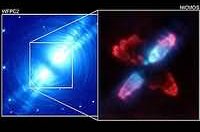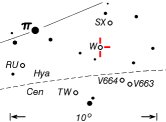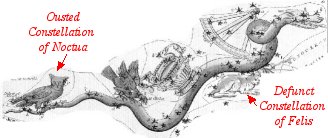Near the tail end of the expansive constellation of Hydra the sea serpent resides the bright southern semiregular-type variable star W Hydrae. The period of W Hya is just shy of a year at 361 days. Based on over 3,400 observations in the AAVSO International Database, the variable has a magnitude range of 5.7-10.0, making W Hya a great star for observers with binoculars and/or small telescopes who can observe to -28 degrees declination.
 |
 |
Edwin F. Sawyer (far left) and Seth C. Chandler, Jr. (near left) were both independent amateur astronomers who made significant contributions to the field of variable stars decades prior to the formation of the AAVSO. Read more here. |
The first record of W Hya's variability came from Edwin Sawyer in 1889 (Sawyer 1889). Inspection of his observations along with the "meagre" data available at the time lead Sawyer to determine the period of the variable to be about a year. In 1893, Seth Chandler reported W Hya to have an amplitude of 1.3 magnitudes over a period of 384 days (Chandler 1893). Later, Paul Merrill noted that the spectroscopic behavior of W Hya resembled that of a typical long period variable and questioned the small range of variability since a typical M8e star with the same period would normally show a greater amplitude of variability (Merrill 1923). According to Yamamoto and Campbell (1924), whether due to the extreme redness of the star or because of its low declination for northern observers, the star was never satisfactorily observed by visual means and little attention was paid to the star through minimum. Yamamoto and Campbell (1924) investigated 800 Harvard photographic plates which covered 24 years and found the range to be almost 3 magnitudes, showing that the star was not abnormal, but in fact belonged to the long period class of variable stars as suspected.
A Star with an Identity Crisis
Long period variables (LPVs) are pulsating giant and supergiant stars of intermediate or late spectral type. Also known as "red variables" for their color, LPVs vary dramatically in optical light and are thought to change temperature and size by about 30% over periods of 10-1000 days. The group is separated into two subclasses based on optical properties: Mira (M) and semiregular (SR), with the latter class further divided into the subtypes of SRa, SRb, SRc, and SRd. Mira variables are the most well-defined and homogeneous type of LPV. The light curves of these variables reveal regular variability with periods between 80 and 1000 days and visual amplitudes of more than 2.5 magnitudes. The closely related group of the semiregulars, particularly the SRa and SRb types, have smaller amplitudes and shorter, less regular periods. While the SRa stars may show persistent periodicity, the SRb stars possess poorly defined periodicity. The SRc stars have amplitudes of less than 1 magnitude and periods of 30 or more days, and the the SRd types show amplitudes of 0.1 to 4 magnitudes and periods of more than 30 days.
W Hya is classified as a semiregular, but with only one dominant pulsation period of 361 days and visual amplitude of 4 magnitudes, it appears to belong more to the Mira class than the semiregular. Jura and Kleinmann (1992) propose that semiregulars with periods between 300 and 400 days appear to belong to the same population as the "thin disk" Miras in the same period range. Alternatively, Kerschbaum and Hron (1992) suggest that SRa stars are not a distinct class of variables but a mixture of "intrinsic" Miras and SRbs. That is, SRas appear to be intermediate objects between Miras and SRbs in terms of periods, temperatures, amplitudes, mass loss rates and the fraction of C-rich stars.
The Mira and semiregular classes seem to be closely related. Although the evolutionary status of semiregular variables is not clear, it is thought that perhaps the semiregular phase may precede the Mira stage during evolution on the Asymptotic Giant Branch (AGB). Early AGB stars tend to be semiregular variables with a low mass-loss rate, which evolve into long-period Mira-type variables where mass loss is more pronounced. The lifetime of the mass-losing AGB is estimated to be 105 years. Before evolving off the AGB the star undergoes an intense period of mass loss leaving behind a hot C/O core which ionizes the surrounding material resulting in a planetary nebula. Thus, the long period variables are critical to our understanding of stellar evolution since they represent the final stages of stellar life.
 |
| A portion of the AAVSO visible light curve for W Hya. Click to enlarge. |
Meandering...Period
 |
| The Hubble view of the Egg Nebula (CRL 2688) in visible light (right) and in infrared light (left). Credit: STScI and NASA. Is W Hya heading for a similar fate, concentric shells and all? Click to enlarge. |
Long-term data show that amplitudes of certain LPVs can change over time, while the periods tend to remain stable. An in investigation into claims of period evolution for some stars carried out by Zijlstra and Bedding (2002) revealed different types of period changes found in Mira stars: continuous, sudden, and meandering. A number of long period Miras, including W Hya, show evidence of meandering periods, where periods change by about 10% over 50 years followed by a return to the previous period. Compared to the other two types, the period change in meandering variables is smaller. The estimation is that no more than 1-2% of Miras show continuous change, sudden changes occur for fewer than 1% of Miras, while meandering periods are found in about 15% of Miras with periods longer than 400 days. Most (or all) Miras with periods longer than 500 days have unstable periods. Period fluctuations in meandering Miras may correlate with mass-loss. For instance, a number of young planetary nebulae, such as the Egg Nebula (CRL 2688), show concentric rings about the source star. The exact origin of these rings is presently not known, but could be due to epochs of enhanced mass loss during the preceding Mira phase, and the mass loss could also result in period changes as the star settles into a new equilibrium state.
The A-mase-ing W Hya
 |
| Schematic of the different zones of W Hya (Reid and Menten 1997). Click to enlarge. |
W Hya is a confirmed source of maser activity. The word "maser" is an acronym for the term Microwave Amplification by the Stimulated Emission of Radiation. Masers are similar to lasers, except that while lasers emit radiation in the visible part of the electromagnetic spectrum masers emit in the form of microwaves. Masers can be thought of as the long wavelength equivalent of lasers.
The maser is a source of near monochromatic coherent radiation. Maser technology is based on the principle of stimulated emission first proposed by Albert Einstein in 1917. The first laboratory maser was constructed in the 1950s and the first cosmic maser was discovered in 1965 in a region of OH gas close to a young star. Hundreds of cosmic masers are now known. Cosmic masers are very bright radio sources that are pumped by energy from the central object. Due to long wavelengths, masers provide valuable information on dusty regions which are undetectable at almost all other wavelengths. Masers can be used to probe comets, stellar and planetary atmospheres,star-forming regions, and circumstellar envelopes. Thus, masers can help provide great insight on a whole host of astronomical objects.
In terms of W Hya, maser emission has been observed from OH, H2O, and SiO molecules. SiO maser emission arises from an area at about 4 AU between the radio photosphere at 2R* and a dense dust formation region at about 3R*, where R* is the stellar radius. Shells of H2O masers are observed at radii near 15 AU and the OH masers at distances out to hundreds of AU (Reid and Menten 1997). At the farthest reaches of the stellar atmosphere, the OH maser emission is a good indicator of the mass loss process, which is strongly related to the star's nature and evolution.
Observe W Hya
 |
| W Hya's position relative to the bright star pi Hya and some other variable stars in the field. |
W Hya is located about 5 degrees southwest of the bright star pi Hya, in the tail portion of the sea serpent constellation of Hydra -- the largest constellation in the sky. Hydra actually used to be even larger, but was divided into four parts by cartographers such as Flamsteed and Hevelius. The result: Sextans, Crater, Corvus, and a reduced Hydra. At its scaled-down size Hydra still dominates the largest portion of the sky bordering 13 other constellations and covering over 1,300 square degrees -- over 3% of the sky. Its great span is equivalent to 172 full moons side by side! The constellation is completely visible from latitudes +55 degrees to -83 degrees, while just portions are visible worldwide (Bakich 1995).
If you are able to view W Hya and are interested in contributing to its light curve, the AAVSO can provide some great tools and tips to help you get started. Observers may generate customized charts used for making brightness estimates of W Hya. According to AAVSO Bulletin 71: Predicted Dates of Maxima and Minima of Long Period Variables for 2008, W Hya is expected to be at minimum around May 11, 2008 and at maximum around October 14, 2008. Observers should plan to monitor W Hya once a week throughout its entire cycle, but because of its red color be sure to observe W Hya with the "quick glance" as recommended in the AAVSO Manual for Visual Observing of Variable Stars. Due to the Purkinje effect, red stars tend to excite the retina of the eye when watched for an extended period of time. Accordingly, red stars appear to become unduly bright, producing an erroneous impression of the relative magnitudes. Observers are advised to look as quickly as possible at the field and make a brightness estimate before falling subject to the fated effect. Submitted observations are added to the database and immediately available to professional and amateur astronomers worldwide!
 |
| "Felis the Cat" is one of the many defunct constellations to be proposed throughout the years before the standardization of the 88 constellations by the International Astronomical Union. Created by French astronomer Lalande, the constellation contained stars between Antila, Hydra, and Pyxis. Lalande's justification for the constellation was, "I am very fond of cats. I will let this figure scratch on the chart. The starry sky has worried me quite enough in my life, so that now I can have my joke with it" (in Star-Names and Their Meanings by R.H. Allen). The constellation first appeared in the 1801 atlas of J.E. Bode, but the beloved domesticated pet has since been erased from the night skies. Although the owl-shaped constellation of Noctua has also been ousted from present-day constellations as well, other bird-shaped constellations remain. |
For more information
- Bakich, Michael E. The Cambridge Guide to the Constellations. New York: Cambridge UP, 1995
- Chandler, S.C., 1893, "Second Catalogue of Variable Stars," Astronomical Journal, 13, 89
- Merrill, P.W., 1923, "The Radial Velocities of Long-Period Variable Stars," Contributions from the Mount Wilson Observatory, 264, 1
- Reid, M.J., and Menten, K.M., 1997, "Radio Photospheres of Long-Period Variable Stars," The Astrophysical Journal, 476, 327
- Sawyer, E.F., 1889, "On a New Variable Star in Hydra," Astronomical Journal, 9, 94
- Yamamoto, I., and Campbell, L., 1924, "The Long Period Variable W Hydrae," Harvard College Observatory Circular, 270, 1
- Zijlstra, A.A., and Bedding, T.R., 2002, "Period Evolution in Mira Variables," Journal of the AAVSO, 31, 2
This Variable Star Of The Season article was prepared by Kerri Malatesta, AAVSO Technical Assistant.

